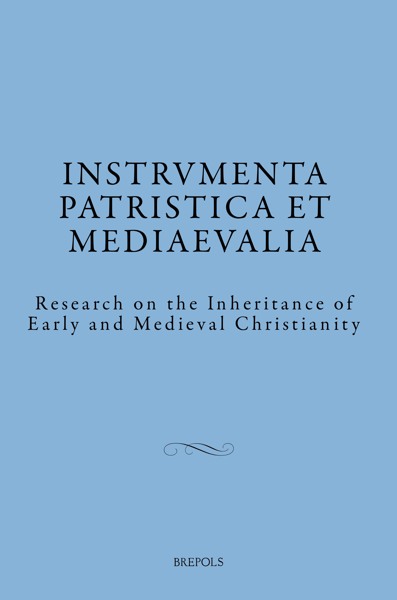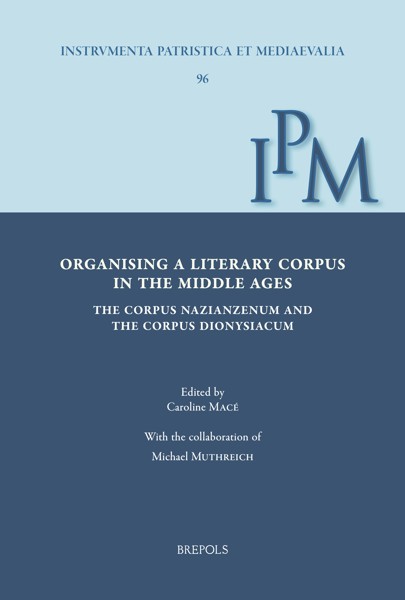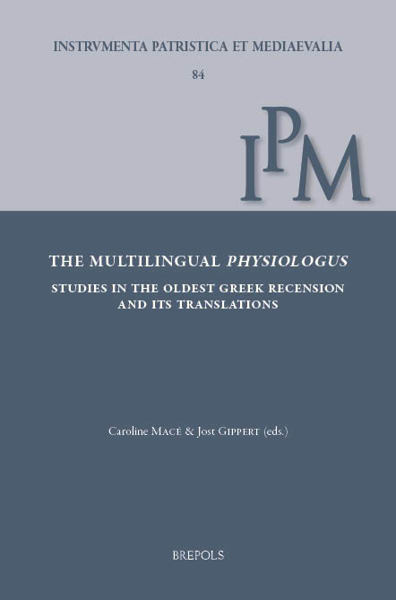
Organising a Literary Corpus in the Middle Ages
The Corpus Nazianzenum and the Corpus Dionysiacum
Caroline Macé (ed)
- Pages: 700 p.
- Size:156 x 234 mm
- Illustrations:6 b/w, 15 col., 12 tables b/w.
- Language(s):English, French, German
- Publication Year:2024
- € 115,00 EXCL. VAT RETAIL PRICE
- ISBN: 978-2-503-61096-2
- Hardback
- Available
- ISBN: 978-2-503-61097-9
- E-book
- Available
The Corpus Nazianzenum and the Corpus Dionysiacum offer two exceptional and contrasted cases to study how literary corpora were shaped and transformed throughout history, cultures and languages.
Caroline Macé is a researcher at the Göttingen Academy of Sciences and the Humanities in Lower Saxony.
Through the word corpus, the metaphor of the body is applied to a collection of works by the same author that are transmitted together. These works not only share the same skin, the manuscript, but also function organically thanks to a complex system of paracontents. It is possible to see this system at work in the case of only a very few medieval authors throughout history, cultures and languages; the Corpus Nazianzenum and the Corpus Dionysiacum are such instances.
Both Gregory of Nazianzus and Dionysius the Areopagite are super-authors, who forged their own literary identity as much as they shaped the body of their writings. This sets both corpora apart from other collections of patristic works. They are also exceptional because of the large scale and enduring character of their cultural impact in the different cultures in which the corpora were translated, commented and annotated. By confronting these two exceptional cases, it is possible to gain some new light on the intellectual and book-historical aspects of literary creation and reception in Late Antiquity and the Middle Ages.
Introduction
1. Caroline Macé: Living Bodies of Texts
2. Ekkehard Mühlenberg: Das Akademievorhaben „Dionysius Areopagita“ in Göttingen
3. Bernard Coulie: Le Centre d’études sur Grégoire de Nazianze à Louvain-la-Neuve
I. Origins and Evolutions of the Corpora
1. Margherita Matera: Le palimpseste Parisinus graecus 1330, le plus ancien témoin manuscrit du Corpus Dionysiacum
2. Caroline Macé: Éléments d’une histoire ancienne de la tradition des discours de Grégoire de Nazianze: les variantes arméno-latines du discours 38
3. Alessandro Capone: Alle origini delle antiche versioni latine delle Orazioni di Gregorio di Nazianzo
4. Véronique Somers: Sur les traces d’une édition byzantine des Discours de Grégoire de Nazianze ?
5. Pierre-Marie Picard: Les divisions mauristes des œuvres poétiques de Grégoire de Nazianze, des sous-corpus évolutifs à interroger
6. Jost Gippert: Ephrem the Minor’s Preface Revisited
7. Maia Matchavariani: Books for Bibliophiles: Two Ancient Collections of the Georgian Translations of Gregory of Nazianzus’ Works – NCM S-1696 and NCM A-87
II. Scholia and Commentaries
1. Chiara Faraggiana: Gehören παρατιθέναι, παραγράφεσθαι, παρακεῖσθαι zum literarischen oder zum kodikologischen Vokabular? Überlegungen über die spätantike Exegese als Paratext
2. Joseph Church: The Ancient Lexica to the Corpus Dionysiacum
3. Thomas Schmidt: Les Commentaires de Basile le Minime aux Discours de Grégoire de Nazianze: le cas particulier du Discours 38
4. Gaëlle Rioual: Basile le Minime, commentateur de quel texte de Grégoire de Nazianze?
5. Jonathan Loopstra: Reading the Corpus Nazianzenum in Syriac by Way of the Margins
6. Emiliano Fiori: School and Scholia in the Syriac Miaphysite Tradition: The Syriacisation of Dionysius the Areopagite as a Collective Exegetical Effort
7. Sergio La Porta: Reading the Areopagite: The Armenian Scholia on the Corpus Dionysiacum and Their Use in the Medieval School Curriculum
8. Thamar Otkhmezuri: The Corpus Nazianzenum and the Corpus Dionysiacum in the Georgian Literary Tradition




